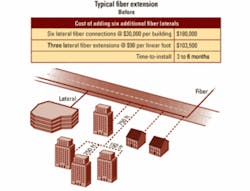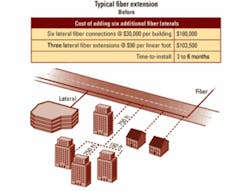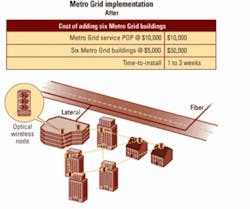Metro builds profit from optical mesh networks
Fortunately, while the economics of trenching lateral fiber extensions to new sites hasn’t notably improved, alternative technologies have. In particular, an emerging model known as the Metro Grid blends the best of wireless, optical, and mesh networking to revamp the business case for fiber-caliber services.
Fiber service providers nationwide-and most municipalities-have endless miles of dark fiber buried beneath the streets of major metro and urban areas, a staggering percentage of it unused. Yet due to the costs of lighting new buildings, small-to-medium businesses run on legacy copper via multiple T1s, Frame Relay, or low-grade DSL, paying up to $1,000 or more monthly for basic telephony and Internet services.
Thus the replacement of legacy links with a single business-grade services bundle presents a significant revenue opportunity. Beyond that, a new market for metro LAN services awaits similar inflection points-15 to 100 Mbits/sec of bandwidth, affordable costs, and predictable quality-through viable access to metro core fiber for the small-to-medium business (SMB) mass market.
To unlock these opportunities, fiber-based service providers must overcome their greatest economic challenge: linking new buildings (see Figure 1). Lateral fiber extensions typically take 3 to 6 months for planning, construction time, and procuring permits. Upfront capital expenditures (capex) start at around $25,000 for reasonably accessible buildings, with extension to additional sites ranging from $50 to $150 per foot according to a 2006 report by Vertical Systems. Nor is a resale market viable, since leasing high-speed or dark-fiber access costs retail providers some $2,000 to $4,000 per month and still requires colocated equipment. So daunting are these costs that just over 10% of buildings with 20 or more employees are accessed by fiber today.The wireless optical mesh network, or “Metro Grid,” revamps the expansion model from the rooftop down. A true multipoint mesh of multiservice nodes, the Metro Grid provides a highly redundant and reliable infrastructure that blends the affordable reach of wireless with the superior quality of optics and the advantages of mesh architecture to provide a highly redundant network.
The wireless optical mesh features two key elements: mesh nodes and a centralized management system. Nodes comprise low-cost optical transmission links tightly integrated with standards-based mesh switching. Each node contains multiple fixed Ethernet service interfaces connecting upstream or downstream, and several can be colocated on the same rooftop to build a fully redundant, resilient metro Ethernet topology. Nodes link together to form a fully automated switching topology, which provides a service distribution mesh based on a resilient multipoint-to-multipoint mesh topology.
The wireless optical mesh is essentially composed of “wire-speed, full-duplex LAN links”-wireless or fixed Ethernet segments, at standard Fast Ethernet or Gigabit Ethernet speeds. The flat Layer 2 service distribution mesh architecture lowers operating expenditures (opex), a key value proposition of Carrier Ethernet architectures.
The central management system provides “over-the-air” management of the mesh as well as automated “mesh operation” tools to provision service capabilities. Central management enables significant opex savings through enhanced diagnostics tools, automated inventory, and revision control and autodiscovery functions.
Beginning at a building already accessed by fiber, a service provider can launch high-speed, high-quality services for upfront costs of less than $10,000 in a matter of days (see Figure 2). The license-free nature of the wireless optical links reduces initial capex further. Secure rooftop nodes provide optical wireless transmission to extend fiber-grade speeds and service levels to additional sites. Linking new buildings is as easy as deploying additional rooftop nodes. Subsequent expansion to connect new customer buildings to the mesh is risk-free and on demand, and a single new SMB customer will justify the cost of the node’s deployment in a matter of months.
With deployment costs of less than $5,000 per building, and average monthly revenues of $1,000 (roughly the cost of two T1s for a single customer), the Metro Grid achieves payback in 6 to 9 months.
This new ROI model changes the economics of deploying high-speed broadband business services across dense metropolitan areas, business parks, and campuses. As customer demand increases, a Metro Grid can quickly and profitably grow from the rooftop of a single fiber-lit building to an optical wireless mesh that can distribute gigabits of fiber-grade service capacity across an entire metropolitan area.
Besides vastly reducing capex, opex, and time-to-profit, the wireless optical mesh enables premium services, SLAs, and sustainable profit margins exceeding 50%. Here, its credibility as a true alternative to lateral extensions lies in delivering fiber-caliber quality and capacity. The wireless optical mesh strikes the balance between cost and quality needed to unlock the SMB market opportunity within metro areas.
Given the choice, many SMBs might absorb the costs of lateral fiber extension (over time) in exchange for guaranteed higher quality. That’s because alternative efforts to link new buildings to a fiber core often can’t ensure business-class service. For example, copper requires colocated bonding equipment and fails to deliver business LAN services beyond 10 Mbits/sec. RF approaches are subject to interference and spectrum congestion when deployed in unlicensed frequency bands, which becomes even more of an issue in dense metropolitan areas. Wi-Fi is designed for mobility, and WiMAX is designed for reach. Neither is designed for metro density.
The wireless optical mesh approach exceeds the performance of these fiber extension alternatives to deliver:
• High-capacity transmission of 100 Mbits/sec per wireless optical link.
• Interference-free operation, even in dense deployments.
• Fiber-grade quality with only microseconds of transmission delay and virtually no jitter.
• Simultaneous, scalable support for thousands of toll-quality voice calls, video streams, and Internet sessions.
• High service capacity to hundreds of buildings housing thousands of customers and distribution scalable to several gigabits per second of fiber-grade service capacity across a metro mesh infrastructure.
Furthermore, unlike RF-based wireless approaches, the more densely the wireless optical Metro Grid is populated, the more reliable and robust it becomes. With more nodes deployed, the grid gains the resilience of multiple alternative paths across an established optical wireless mesh. Service availability across the metro area becomes greater, so to speak, than the sum of its parts.
Without the requirement to trench across city streets, the Metro Grid lets fiber and wireless service providers target the underserved metro SMB market with business-class services at 5 to 100 Mbits/sec. SMBs, in turn, will rapidly adopt services delivering the elusive “magic triangle” of benefits: better, faster, and cheaper.
The Metro Grid model retains the flexibility and cost-efficiency of license-free wireless, while maintaining the high service capacity and fiber-grade service quality of optical transmission. It minimizes upfront investments of dollars and days, allowing “pay-as-you-grow” expansion driven by customer demand, and delivers an infrastructure impervious to the pitfalls of earlier alternatives.
With the convergence of mesh, optics, and wireless, all three elements can travel where none have gone before: from rooftops to the bank and back again.Fima Vaisman is senior vice president of marketing at ClearMesh Networks (www.clearmesh.com). Throughout most of his career, Vaisman has been responsible for driving technology, product, and marketing strategy for enterprise and carrier access solutions. Prior to joining ClearMesh, he held sales and marketing positions at Sabeus, Centillium Communications, Accelerated Networks, and ACT Networks.


